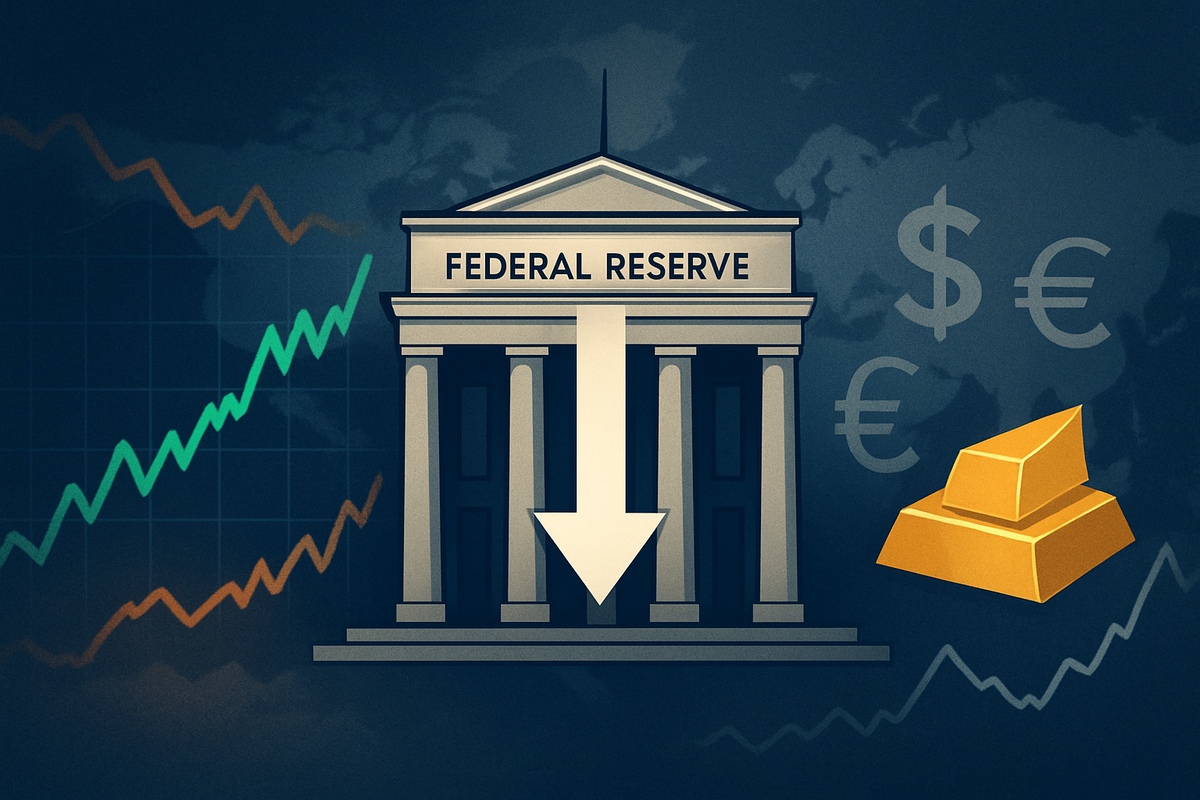
The financial world is abuzz as the U.S. Federal Reserve has decisively executed a "dovish pivot," signaling a profound shift towards an accommodative monetary policy. With financial markets now pricing in a near 100% probability of another interest rate cut at the upcoming October 28-29 Federal Open Market Committee (FOMC) meeting, following an initial reduction in September 2025, investors worldwide are grappling with the implications of cheaper money. This strategic reversal, driven primarily by a softening domestic job market and persistent, albeit stubborn, inflation, is reshaping investor sentiment from Wall Street to Tokyo and London.
This pivotal move by the Fed aims to inject liquidity and stimulate economic activity, responding to what Chair Jerome Powell has termed a "less dynamic and somewhat softer labor market." The immediate consequence has been a palpable "risk-on" sentiment across global equity markets, pushing major indices to new historic highs. However, underlying anxieties about economic jitters, potential asset bubbles, and ongoing political uncertainties continue to temper the euphoria, setting the stage for a complex and potentially volatile period in financial history.
The Fed's Strategic Retreat: A Deep Dive into the Dovish Shift
The Federal Reserve's dovish pivot became unequivocally clear with its 25-basis-point interest rate cut in September 2025, the first since December 2024, bringing the federal funds rate to a range of 4.00%-4.25%. This move, widely interpreted as a "risk management cut," was designed to preempt a potential surge in unemployment and support a weakening labor market. Policymakers largely anticipate further easing through the remainder of 2025, cementing expectations for a sustained cycle of rate reductions.
The primary catalyst for this shift is a U.S. labor market showing clear signs of deceleration. The unemployment rate edged up to 4.3% in August 2025, accompanied by weak average monthly increases in nonfarm payrolls for July and August, and significant downward revisions to previous job gains. Further indicators, such as the ISM's services employment index remaining in contraction territory for four consecutive months and a 58% year-over-year drop in announced hiring plans, underscore the decline. Compounding this, an ongoing government shutdown in October 2025 has delayed crucial economic reports, forcing the Fed to rely on private-sector data and amplifying concerns about job losses and policy uncertainty.
Adding complexity to the Fed's mandate is the persistent challenge of stubborn inflation. Despite the softening labor market, Core Personal Consumption Expenditures (PCE) inflation remained stubbornly at 3.1% in July 2025, with overall PCE inflation estimated at 2.7% in August—both consistently above the Fed's 2% target. Tariffs have also been explicitly acknowledged by Chair Powell as a contributor to higher goods inflation. This delicate balancing act between addressing inflation risks and mitigating recessionary threats highlights the internal debate within the Fed, with some officials still emphasizing "upside risks" to inflation, even as the central bank leans towards easing.
Initial market reactions to the dovish pivot have been swift and pronounced across global financial centers. Equity markets have surged, driven by the expectation that lower borrowing costs will boost corporate profits and encourage investment. Bond yields have declined, reflecting reduced returns for fixed-income investors. The U.S. dollar has generally weakened, as lower interest rates diminish its attractiveness for yield-seeking investors, while non-yielding assets like gold have soared to unprecedented highs, surpassing $4,000 per ounce, appealing to those seeking safe havens amidst monetary policy shifts and geopolitical uncertainties.
Corporate Fortunes in a Lower-Rate Environment
The Federal Reserve's dovish pivot is set to create distinct winners and losers across the corporate landscape, as businesses adapt to a new era of cheaper credit. Growth-oriented companies, particularly within the technology and artificial intelligence (AI) sectors, are poised to be significant beneficiaries. Reduced borrowing costs will lower their capital expenditures for research and development, expansion, and hiring, thereby enhancing future earnings potential and supporting higher valuations. Companies like Microsoft (NASDAQ: MSFT), Apple (NASDAQ: AAPL), and emerging AI powerhouses stand to gain as investor confidence in growth stocks strengthens.
The housing and real estate sectors are also expected to experience a renewed surge. Lower mortgage rates will make homeownership more affordable, stimulating demand and potentially boosting the revenues of homebuilders like D.R. Horton (NYSE: DHI) and real estate investment trusts (REITs). Similarly, businesses with high leverage, across various industries, will see their debt servicing costs decrease, improving their profitability and financial flexibility. This could provide a much-needed lifeline or a competitive advantage for companies that have significant outstanding debt.
Conversely, the financial sector, particularly traditional banks, may face headwinds. While lower rates can stimulate lending demand, they also tend to compress net interest margins (NIMs), the difference between the interest banks earn on loans and pay on deposits. This narrowing spread can impact profitability, potentially leading to adjustments in lending practices or a search for alternative revenue streams. Banks such as JPMorgan Chase (NYSE: JPM) and Bank of America (NYSE: BAC) will need to strategically navigate this environment to maintain robust financial performance.
Beyond direct interest rate impacts, the overall stimulus to the economy from lower rates could lead to increased consumer spending, benefiting retail and consumer discretionary companies. However, the underlying economic jitters and persistent inflation, coupled with the potential for an "AI bubble" as some analysts suggest, mean that even favored sectors will need to demonstrate strong fundamentals and prudent management to truly thrive in this evolving economic climate.
Wider Significance: Reshaping Global Economic Dynamics
The Federal Reserve's dovish pivot is not merely a domestic policy adjustment; it represents a major global economic trend with far-reaching implications. This shift fits squarely into a broader industry trend of central banks worldwide grappling with the dual challenges of slowing economic growth and persistent inflationary pressures. While the Fed leads, other major central banks in Europe and Asia are closely watching, and some may follow suit to maintain competitive economic stances or address their own domestic concerns. The European Central Bank (ECB) and the Bank of Japan (BOJ), for instance, will face renewed pressure to adjust their own monetary policies in response to the Fed's actions, potentially leading to a synchronized global easing cycle.
The ripple effects on competitors and partners are significant. A weaker U.S. dollar, a typical outcome of rate cuts, makes U.S. exports more competitive globally, potentially benefiting American manufacturers. Conversely, it makes imports more expensive, which could further fuel domestic inflation or encourage companies to localize supply chains. For emerging markets, lower U.S. rates often translate to increased capital inflows as investors seek higher yields, potentially supporting growth but also introducing vulnerabilities if these flows suddenly reverse. Countries heavily reliant on U.S. trade or dollar-denominated debt will feel these shifts most acutely.
Regulatory and policy implications are also substantial. The Fed's actions underscore its ongoing commitment to its dual mandate of maximum employment and price stability, even as the path to achieving both becomes increasingly complex. The internal debates within the FOMC, highlighting the tension between addressing inflation and preventing a recession, will likely lead to increased scrutiny of the Fed's decision-making process. Historically, periods of aggressive easing have sometimes led to asset bubbles or exacerbated inflationary pressures down the line, prompting policymakers to carefully consider the long-term consequences of their current actions. Comparisons to previous easing cycles, such as those following the 2008 financial crisis or the early 2020 pandemic response, will be drawn to assess the efficacy and risks of the current strategy.
The global financial architecture is intrinsically linked, and the Fed's move will inevitably influence international capital flows, currency valuations, and commodity prices. While providing a short-term boost to risk assets, it also raises questions about the sustainability of current market valuations and the potential for unintended consequences in an interconnected global economy.
What Comes Next: Navigating the Uncharted Waters
Looking ahead, the Federal Reserve's dovish pivot sets the stage for a period of dynamic market adjustments and strategic reorientations. In the short term, the market's near 100% expectation of an October rate cut suggests that further "risk-on" sentiment is likely to persist, particularly in growth-oriented sectors. Investors will be closely watching for subsequent FOMC statements and economic data releases, especially those pertaining to employment and inflation, to gauge the pace and extent of future rate reductions. The Fed's communication will be critical in managing market expectations and preventing undue volatility.
Long-term possibilities include a sustained period of lower interest rates designed to stimulate economic growth and ensure full employment. This could lead to a re-evaluation of investment strategies, favoring assets that perform well in a low-yield environment. Potential strategic pivots for corporations will involve optimizing capital structures to take advantage of cheaper borrowing, investing in expansion and innovation, and potentially reconsidering merger and acquisition opportunities. Companies that can adapt quickly to these new financial realities will likely emerge stronger.
Market opportunities may emerge in areas such as renewable energy, infrastructure, and emerging technologies, which often require significant upfront capital and can benefit from lower financing costs. Conversely, challenges may arise from potential inflationary pressures resurfacing if the economy overheats, or from a weakening dollar that could make imports prohibitively expensive. The ongoing global geopolitical uncertainties also present a significant wild card, capable of derailing even the most carefully calibrated monetary policies.
Potential scenarios include a "soft landing" where the Fed successfully navigates the economy to stable growth and inflation without triggering a recession. However, a less favorable outcome could see the economy slip into a recession despite rate cuts, or an environment where inflation remains stubbornly high, forcing the Fed into another difficult balancing act. Investors should prepare for increased market volatility as these scenarios unfold and the Fed continues to react to incoming economic data.
Wrap-Up: A New Chapter for Global Finance
The Federal Reserve's dovish pivot marks a significant turning point in global financial markets, ushering in an era defined by aggressive interest rate cuts aimed at bolstering a softening job market. The near certainty of an October 2025 rate cut, following the initial reduction in September, underscores the Fed's commitment to supporting economic activity, even as it grapples with persistent, above-target inflation. Key takeaways include a pronounced shift to "risk-on" sentiment in equities, declining bond yields, a weakening dollar, and a surge in safe-haven assets like gold.
Moving forward, the market will remain highly sensitive to economic indicators, particularly those related to employment, consumer spending, and inflation. The Fed's future policy decisions will be closely scrutinized for any signals regarding the pace and duration of this easing cycle. Corporations will need to strategically adapt, with growth-oriented firms and those in real estate poised to benefit, while financial institutions may face margin pressures.
The lasting impact of this pivot could be a redefinition of investment paradigms, potentially favoring long-term growth and capital-intensive projects. Investors should watch for further clarity on the Fed's long-term inflation outlook, the trajectory of the U.S. labor market, and any potential shifts in global central bank policies. The delicate balance between stimulating growth and controlling inflation will continue to be the central challenge for policymakers, shaping the financial landscape for months and possibly years to come.
This content is intended for informational purposes only and is not financial advice




